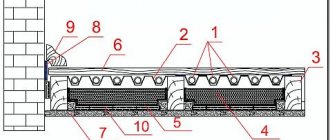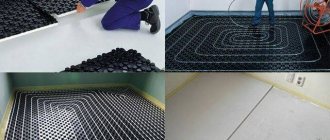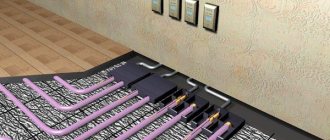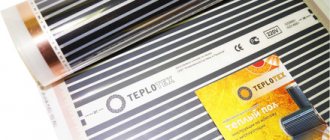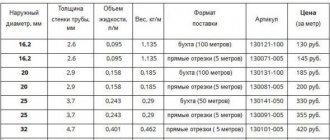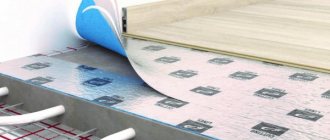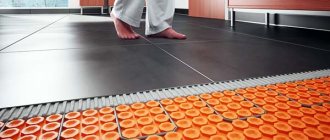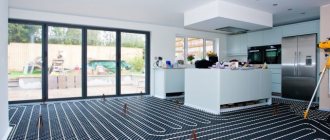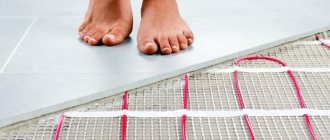Having heated floors in your home, you can already appreciate the benefits of such a space heating system. For those who have tried all the advantages of this heating method, it is quite natural to want to achieve the same effect in other objects associated with our everyday life. Here we can talk about heating a country house or consider a bathhouse as a heating object.
For us, the bathhouse is considered the standard of comfort, in which the main factor is warmth and comfort. Creating the necessary atmosphere inside a bathhouse is perhaps the main task that one has to face during the construction of a bathhouse. A warm water floor installed in a bathhouse can radically solve the heating problem. In addition, this heating option is not only highly efficient and economical, but also improves the comfort of the bath room.
Advantages and disadvantages of the solution
Advantages of installing warm water floors in a bathhouse:
- creating more pleasant conditions in the steam room and washing room;
- maintaining a constant room temperature, dry conditions;
- system safety and reliability;
- Possibility of combination with any type of floor covering;
- economical energy consumption;
- long service life.
Disadvantages of the technique:
- labor-intensive and time-consuming installation;
- the need to purchase expensive materials.
What does a water heated floor in a bathhouse look like?
You also need to take into account that the implementation of the system entails additional costs for maintenance and maintaining the required temperature conditions.
Installation of underfloor heating from a furnace
A stove can act as a boiler for heating the coolant in a bathhouse.
The disadvantage of this heating system will be the slow heating of the room itself, because a lot of heat will be used to heat the floor covering. For heating from a sauna stove, a heat exchanger device is installed above the firebox. The arrangement also requires pipes and a circulation pump, provided the stove is located above floor level. The parameters of the heat exchange device built into the furnace are sometimes insufficient and require the installation of a battery tank next to it.
Choice of flooring, coolant features
When arranging a traditional Russian bathhouse with your own hands, you usually assemble wooden flooring due to its aesthetics and authenticity, environmental friendliness and ease of installation. Less common is a floor laid with ceramic tiles using frost-resistant adhesive. The latter must contain at least 40% mineral additives, preferably uniformly white and uniform in consistency mixtures.
Since heating in the bathhouse is not regular, in winter there is a high risk of water freezing and damage to pipes. Antifreeze used in heated floors as a coolant consists of diluted glycol; if metal pipelines are installed, anti-corrosion additives are welcome. It is important to ensure complete sealing of the joint area to prevent contact of antifreeze with air.
The liquid can be heated from a stove with a water circuit or from a boiler. In the first case, it is assumed that a heat exchanger is installed from a metal tank. If you use a grate welded from pipes for this purpose, the floors will heat up faster and better. The circulation of coolant in the system is ensured by a pump.
General principles for laying water heated floors in a bathhouse
Methods for assembling the structure depend on the materials used:
- a flexible pipe is placed directly under the finished floor, covering the entire area; the working fluid flows through it;
- the maximum possible length of such a pipe is 100 m; if it is laid in a spiral, a distance of less than 40 cm should be left between its turns. As a result, one product covers a floor area of 15 square meters. m;
- Several similar preparations are introduced into large premises. In particular, for a steam room with an area of about 30 square meters. m will need two segments of heated floors of 15 square meters each. m;
- in a scheme with two pipes, the ends are sent to the manifold cabinet, where they are combined. A coolant heated by a boiler or furnace is supplied to the bundle, resulting in heating of the room.
When choosing a location for a manifold cabinet, convenience is a priority, because the ends of the pipes serving the heated floor are placed in it. As a rule, a niche in the wall is prepared for it.
Gas heating system
When connected to a gas main, heating a bathhouse with gas is the fastest and most efficient option for the system.
The system has two implementation options:
- traditional heater equipped with a gas burner;
- gas boiler with installation of heating radiators and water pipes.
The undoubted advantage of such heating is the absence of unpleasant odors, the formation of soot and soot. At the same time, gas equipment has a compact body, low weight and does not require much space during installation. The power of a standard boiler reaches 45 kW, which is enough to heat a room up to 280 square meters. m.
Overview of tools and materials
You need to prepare:
- heat exchanger (aka coil), usually made from a section of an inch pipe with a length of 3 m, exactly adjusted to the parameters of the furnace;
- storage container - optimally this is a stainless steel barrel, the wall thickness of which exceeds 5 mm. A breather is installed into it, protecting the system from steam formation. The minimum total volume of the storage tank and pipes is 100 l;
- thermostat;
- bypass, optimizing the forward and reverse direction of movement of the working fluid;
- three-way valve to the bypass;
- the main working tool is a circular pump;
- pipes;
- a distribution manifold that ensures the movement of coolant in the circuits.
For a water heated floor in a bathhouse, you will need a distribution manifold.
You will need additional components such as insulation, vapor and waterproofing, fittings, fittings, substrate, and fasteners.
Preparatory work: design
To lay heated floors, 2 patterns can be used - snake and snail. The first method is relevant for premises whose area does not exceed 10 square meters. m. When using a snake in spacious baths, only one half is fully heated; on the surface of the second, the temperature is noticeably lower. To compensate for heat losses, it is necessary to provide a smaller installation step. Here the standard figure is 30 cm, in the second half of the bath it is reduced first to 20 cm, then to 15 cm.
The spiral method is more universal; its popularity is facilitated by the ease of installation and the possibility of uniform heating of the floor. The pipe is led in a circle without sharp bends, and pressure losses along the line are reduced. For comparison: forming a snake involves bending the pipeline 180°, while for a snail 90° is sufficient.
If a compact bathhouse is being installed, heated floors are installed into it using the snake method. The justification of the solution lies in the small floor area; we also have to take into account that the temperature of the coolant in the circuit rarely exceeds 30-35 ° C; in this mode, heat loss is almost invisible.
Water heated floor in the bathhouse is an excellent solution
The assembly of the system in the bathhouse is preceded by careful preparation of the base. Dust, debris, and stones are removed from the primary coating. A deeply penetrating primer is applied to the entire surface. Next comes the waterproofing layer, the most practical option is ceresite or ready-made self-leveling mixtures. Roofing felt and bitumen mastics are not suitable here.
Electricity as it is
Electric heated floors come in several types. The heater can be in the form of a wire - double or single. The two-core one is more convenient to install, it does not need to be ringed, it is laid in one direction and a plug is simply placed at its end.
The single-core wire is laid with the expectation that both ends need to be connected to the controller. Don't forget about the temperature sensor. Its installation is also mandatory and is done on the floor between the turns of the cable.
A system with a single-core wire is easy to install, but has a significant drawback: it produces high electromagnetic radiation. When using a two-core wire, electromagnetic radiation is much less due to counter magnetic fluxes.
For floors made in the form of rolls or mats, electromagnetic radiation is significantly lower. But there are restrictions on their use.
The power of thermal mats ranges from 150 to 450 W per square meter of surface. For bath floors, 250 W per square meter is considered optimal.
Installation technology
Depending on the base material, it is practiced to install a wooden, polystyrene, or concrete heated water floor.
Concrete
It is widely used in Russian latitudes, it is based on a concrete screed with a flexible pipe; it also uses insulation in tandem with polyethylene film. Mineral wool and penoplex are optimal as thermal insulation materials. Concrete is mixed with special additives (they are also used in the construction of swimming pools), which prevent cracking of the dry mass under conditions of frequent temperature changes.
Preparing the base:
- the screed is made with an inclination corresponding to the direction of drainage of water, the maximum angle is 10°;
- the completely dried layer is covered with a polyethylene vapor barrier;
- insulation is laid on top - mineral wool, penoplex;
- holes are formed in the material into which beacons for future screed are placed;
- The top of the “pie” is covered with a metal reinforcing mesh with a cell size of 10x10 cm.
Polyurethane foam tape is fixed along the perimeter along the walls: a soft membrane compensates for the potential expansion of concrete and prevents it from cracking when heated.
The pipe is laid in a spiral taking into account the following recommendations:
- between the turns you need to leave gaps no wider than 40 cm, a distance of 25 cm should be maintained from the outer pipe to the walls;
- When laying a pipeline, the permissible radius of its bend should be taken into account - this is five times the diameter. The product is sold in the form of reels, they are unwound as they are used, fixed with clamps so that there is space for pipe expansion;
- the pipes are combined into a circuit in a manifold cabinet.
After trial testing, the concrete screed is poured again.
It is important that the ambient temperature is kept in the positive range; a vibrator is used to compact the mass. The optimal layer thickness allows you to leave 2 cm of concrete above the pipes; usually it ranges from 7-8 cm. If a tiled floor covering is planned, 5 cm is enough.
Wood
The flexible pipe is placed in the grooves left between the slats; this space should be wider than 2 cm. Chipboard panels are considered the most budget-friendly base material. Operating procedure:
- The base is leveled and debris is removed.
- A sheathing is formed from timber with a cell side of at least 60 cm, and fiberboard or plywood is stuffed onto it.
- The finished raised floor is covered with a vapor barrier and insulation on top.
- Lay out the boards, in the gaps between which the pipe will be placed. Their height should exceed 2 cm.
- The grooves are insulated with foil to prevent heat leakage downwards, and pipes are placed on it.
- All ends are connected to the manifold cabinet.
- A finishing layer of cladding is formed.
To fix the foil in the gaps, you can use small nails or a stapler. If the raised floor is assembled from fiberboard, foil is glued to the smooth surface of the slabs using double-sided tape.
From polystyrene plates
The base is assembled from segments with ready-made grooves; pipes are inserted into them. Plates are inserted into the gaps to promote more uniform heat distribution. A low and light structure is formed that does not “eat up” the usable space in the room. No labor-intensive concrete screeds are needed here. Polystyrene does not allow moisture to pass through and retains its heat-insulating properties throughout its entire service life.
Installation features:
- the first layer is laid insulation in the form of mineral wool;
- polystyrene foam is installed starting from the far corner, the plates should be placed so that their grooves coincide;
- distribution plates are placed in the holes;
- A flexible pipe is fixed on top.
Polystyrene boards
After checking the functionality of the system, a final floor covering is formed.
Common mistakes that accompany self-installation
To ensure stable operation of the system, it is important to eliminate the conditions for the occurrence of the following defects at the preparation stage:
- You can start assembling the heated floor only after 2 weeks have passed from the moment the rough screed is formed. Otherwise, the concrete will crack;
- before installing the finished floor covering, you should test the heated floor scheme so as not to brick up any errors;
- when creating a “pie” it is important to use high-quality insulation materials;
- you need to remember about the limitation regarding the length of one pipe - 100 m;
- a mandatory measure is fixation of compensation tape around the perimeter.
If the installation of the system was carried out taking into account the indicated vulnerable points, you can expect long and uninterrupted functioning of the heated floors.
The final stage: warm floor under tiles
A small screed was poured with a rough floor leveler, leveling the horizon. Floor porcelain tiles from the “kerama marazzi” collection were laid on it. Very high quality material, I recommend it for use. We had to lay out a mosaic in the sink because a slope was needed to drain the water. I also enjoyed working with mosaics; the result turned out better than expected.
It's time to take stock. Express all the pros and cons about such an interesting invention. Conclusions are drawn specifically from this project.

